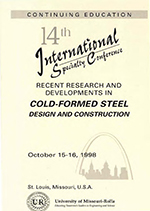Session Dates
15 Oct 1998
Abstract
Built-up cold-formed steel sections may offer greater economy in building construction. Typical built-up sections are cellular decks or door and window header beams. A research project was initiated to determine if the current spacing criteria outlined in Section D1.2 of the AISI Specification accurately predicted the capacity of built-up sections with the cover plate in compression. This study showed that criteria No.2 of the AISI Design Specification spacing criteria is restrictive when applied to built-up cross sections in bending. All test sections continued to carry additional load after the cover plate buckled. The tests showed that as the spacing of connectors increased the moment capacity of the section decreased. An analytical procedure was developed to compute the nominal moment capacity for a range of connector spacings.
Department(s)
Civil, Architectural and Environmental Engineering
Research Center/Lab(s)
Wei-Wen Yu Center for Cold-Formed Steel Structures
Meeting Name
14th International Specialty Conference on Cold-Formed Steel Structures
Publisher
University of Missouri--Rolla
Document Version
Final Version
Rights
© 1998 University of Missouri--Rolla, All rights reserved.
Document Type
Article - Conference proceedings
File Type
text
Language
English
Recommended Citation
LaBoube, Roger A.; Yu, Wei-wen; and Jones, Michael L., "Spacing of Connections in Compression Flanges of Built-up Cold-formed Steel Beams" (1998). CCFSS Proceedings of International Specialty Conference on Cold-Formed Steel Structures (1971 - 2018). 4.
https://scholarsmine.mst.edu/isccss/14iccfsss/14iccfsss-session10/4
Spacing of Connections in Compression Flanges of Built-up Cold-formed Steel Beams
Built-up cold-formed steel sections may offer greater economy in building construction. Typical built-up sections are cellular decks or door and window header beams. A research project was initiated to determine if the current spacing criteria outlined in Section D1.2 of the AISI Specification accurately predicted the capacity of built-up sections with the cover plate in compression. This study showed that criteria No.2 of the AISI Design Specification spacing criteria is restrictive when applied to built-up cross sections in bending. All test sections continued to carry additional load after the cover plate buckled. The tests showed that as the spacing of connectors increased the moment capacity of the section decreased. An analytical procedure was developed to compute the nominal moment capacity for a range of connector spacings.



